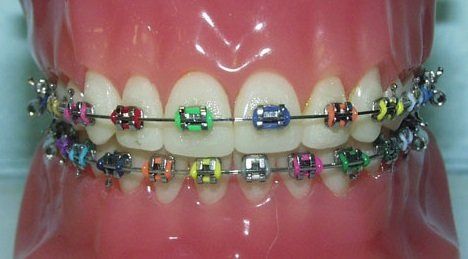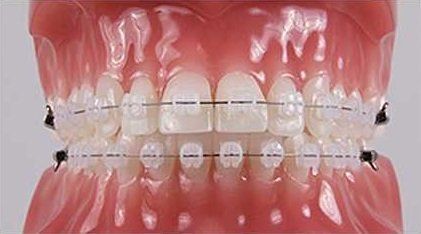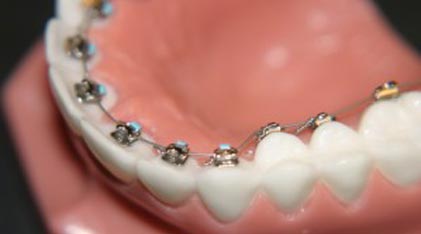Dental Braces
Orthodontic treatment options vary depending upon the severity of the need and the age of the patient.
The most common time for orthodontic treatment is between the ages of 11 and 14. At this time, most if not all of the permanent teeth are in place and crowding, spacing, or bad bites are often noticeable. Treatment is usually best tolerated and most efficient when completed early as a child or adolescent as opposed to as an adult. Additionally, because growth is not yet completed, we have the ability to use the remaining growth potential to help move the teeth into their ideal positions and correct bite problems. The length of treatment varies depending on the nature of your bite. Minor changes can be corrected in less than 6 months while major changes can take up to 36 months. The average is usually about one and a half to two years.
We recommend a child’s first orthodontic visit at age 7. This is the perfect time to evaluate a child’s growing bite and include any preventive treatments as needed. However, orthodontic treatment can be performed at any age. We treat patients from age 7-87 because we want you to have a happy and healthy smile at any age. There are many reasons to seek orthodontic treatment; to learn more visit Who Needs Orthodontics.
At Odhner Orthodontics, we want you to be happy not only with your final smile, but during your orthodontic treatment as well which is why we offer many options for you to choose from:
Book A Free Consultation
We will get back to you as soon as possible.
Please try again later.
Type of Braces

Metal Braces
Traditional metal braces offer superior durability and are often considered the standard for orthodontic treatment. Today, modern metal braces are smaller and more comfortable than ever. Many adolescent patients prefer metal braces and even look forward to changing the colors at each visit. You can click here to get an idea of your Color Choices and plan ahead for each visit.

Clear (Ceramic) Braces
Clear braces are a popular choice for teens and adults who want to make a less noticeable statement while wearing braces. Clear braces today offer unmatched esthetics and are proven to be as efficient as traditional metal braces. Due to the higher cost to manufacture these ceramic brackets, there is a slightly higher cost for clear braces but it is worth it for those that want to be more discrete about their orthodontic treatment.

Lingual Braces
Lingual braces are braces that are placed on the inside of your teeth. They are ideal at hiding the brackets and wires so they are not noticeable during treatment. It is important to be aware that there is a significant adjustment period while getting used to these braces. Some speech disruption and oral discomfort should generally be expected. Given time, the tongue will adapt and you are left with the benefit of being discrete while your teeth are aligned. Due to the higher cost to manufacture these lingual braces, and longer appointments to make adjustments, there is a moderate increased cost for lingual braces.
What Are “Braces”
Dental braces (also known as orthodontic braces, or braces) are devices used in orthodontics that align and straighten teeth and help to position them with regard to a person’s bite, while also working to improve dental health. They are often used to correct underbites, as well as malocclusions, overbites, crossbites, open bites, deep bites, crooked teeth, and various other flaws of the teeth and jaw. Braces can be either cosmetic or structural. Dental braces are often used in conjunction with other orthodontic appliances to help widen the palate or jaws and to otherwise assist in shaping the teeth and jaws.
How Do Braces Work?
Whether using traditional braces, clear aligners, or other orthodontic appliances, the mechanisms of how teeth move are still the same: gentle, continuous forces are used to activate cells in our mouth to undergo healthy bone turnover which allows the teeth to move to a new position in the bone. If forces used were too strong, or too heavy, there would be unhealthy bone turnover reactions and it would be harmful to your teeth. If that sounds complicated don’t worry, Dr. Odhner is an orthodontic specialist who is trained to understand the biology of tooth movement so that she can safely move your teeth.
- For braces, new wires are placed into the brackets at each appointment. Each new wire is programmed to create specific forces needed to move the teeth into their new position.
“Tightening” Your Braces
Dr Odhner will see you about once every 6 weeks to adjust or ‘tighten’ the braces. What this means is that the previous wire is removed, and a new slightly stronger wire is put in its place. There is no actual tightening. The wires are held by color ties, which means you can pick new colors at each visit, or change your clear ties if you have chosen clear braces. Children and teens often change them for school spirit, upcoming holidays, or to match friends!

A family orthodontist serving children, teens, and adults. Braces l Invisalign ; Teeth Straightening Options
TREATMENTS
COMPANY
All Rights Reserved | Odhner Orthodontics








